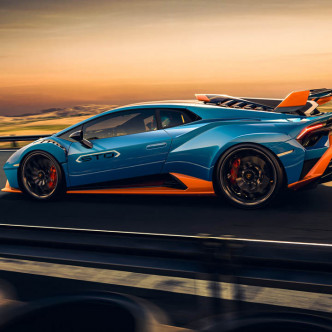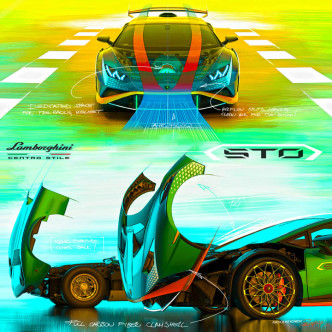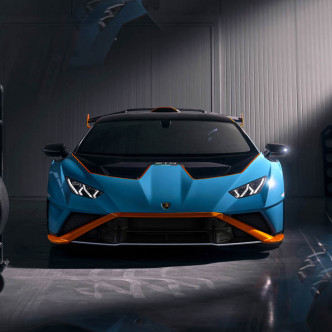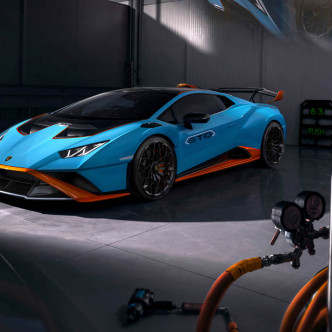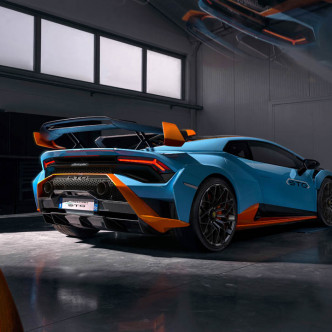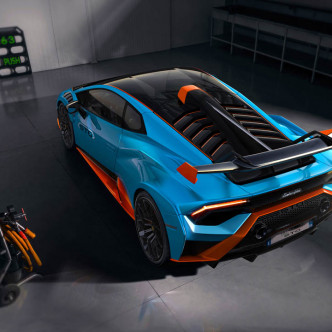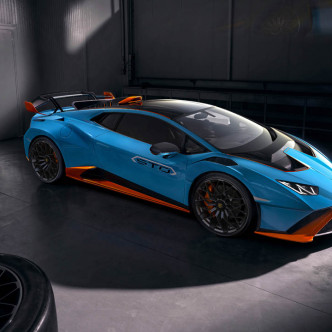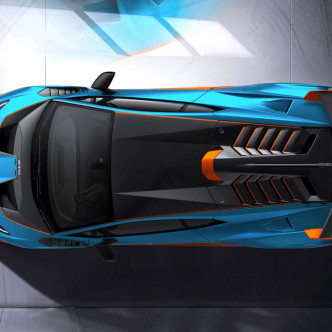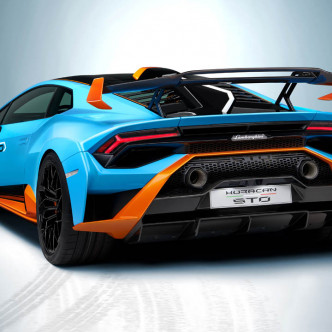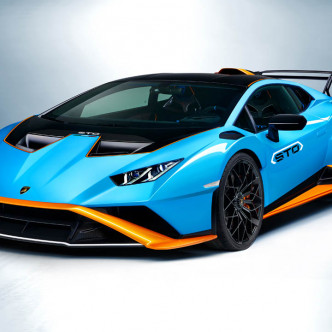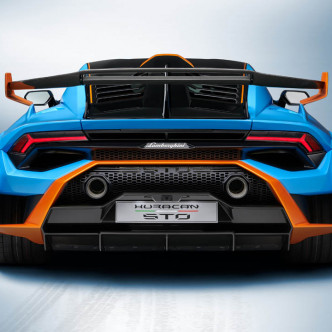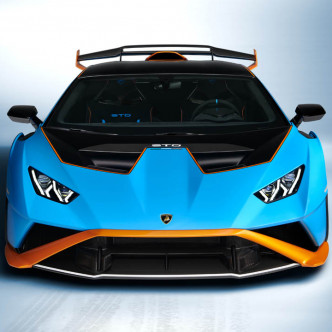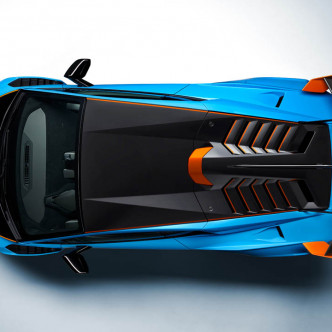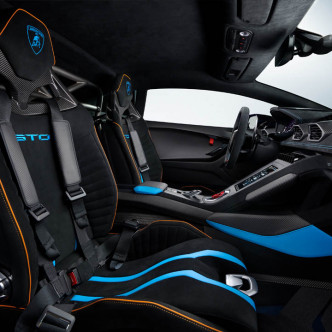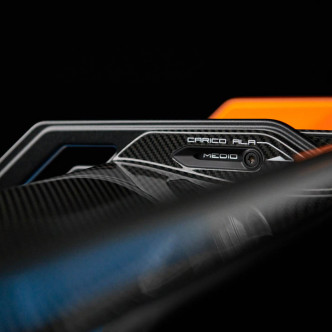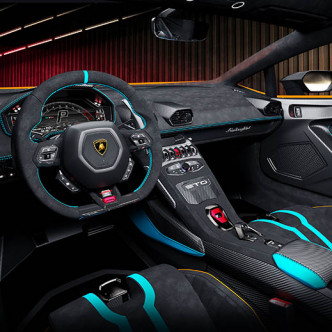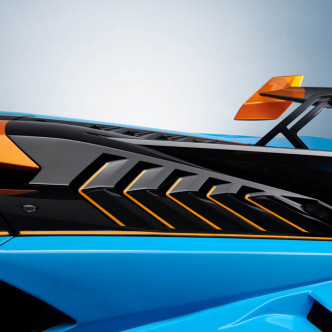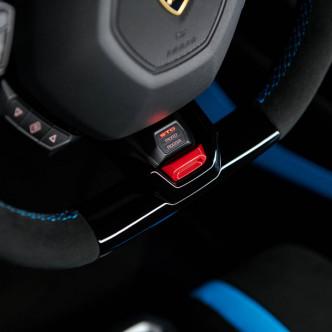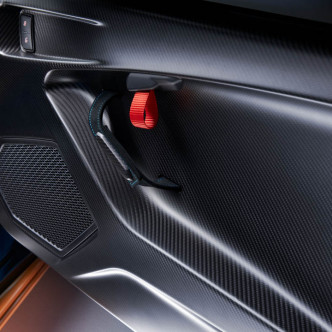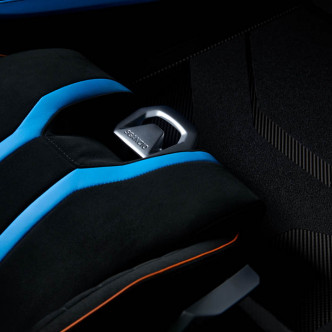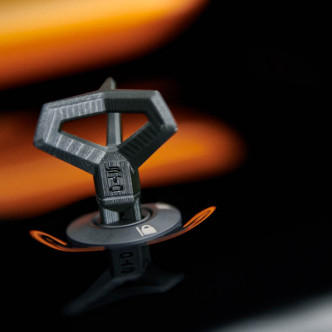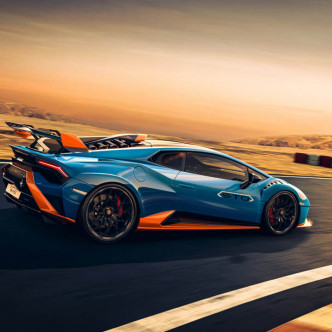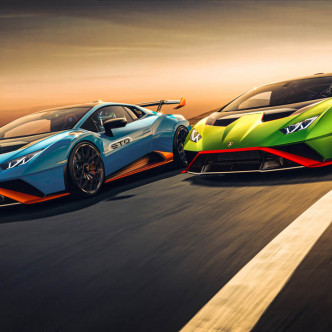Racetrack to road: the new Lamborghini Huracán STO
- The purest concentration of Squadra Corse’s motorsports prowess, drawn from Lamborghini Huracán Super Trofeo EVO and GT3 EVO racecars, in a street-homologated super sports car
- Unique Lamborghini lightweight solution with superior aerodynamics and race car engineering, creates the most authentic driving feeling, every time
- Power of 640 hp (470 kW), 565 Nm of torque at 6,500 rpm, weight to power ratio of 2.09 kg/hp, acceleration from 0-100km/h in 3.0 seconds, braking 100 km/h-0 in 30.0 meters, 200 km/h-0 in 110.0 meters, with the dynamic pace and handling to deliver lap records
Automobili Lamborghini presents the Lamborghini Huracán STO - Super Trofeo Omologata: a road-homologated super sports car inspired by the racing heritage of Lamborghini Squadra Corse’s one-make race series with Huracán Super Trofeo EVO, as well as its three-time 24 Hours of Daytona-winning and two-time 12 Hours of Sebring-winning Huracán GT3 EVO.
With its V10 naturally aspirated 640 hp (470 kW) power plant producing 565 Nm at 6,500 rpm, the rear-wheel drive Huracán STO delivers exhilarating acceleration of 0-100 km/h in 3.0 seconds, 0-200 km/h in 9.0 seconds and a top speed of 310 km/h. However, its heart beats with the exhilaration and emotion of a racecar. Superior aerodynamic efficiency, extensive use of lightweight materials, unfettered steering and first-class braking performance, ensure the Huracán STO delivers the emotion of a track experience on every road drive.
“The Huracán STO is the purest incarnation of Lamborghini Squadra Corse heritage, directly transferring technologies from the Huracán Super Trofeo EVO and drawing on the Huracán GT3 EVO’s unique accomplishment of winning three consecutive times in the Daytona 24 hours,” said Automobili Lamborghini Chairman and CEO, Stefano Domenicali. Maurizio Reggiani, Chief Technical Officer added: “The Huracán STO delivers all the excitement of a beautifully balanced, lightweight and aerodynamically superior super sports car, mirroring the driving feeling and exhilaration of Super Trofeo, and perfectly set up for the world’s most demanding tracks but created for the road. The extensive technical solutions and intelligence gained from both our Super Trofeo and GT3 programs has been refined and embodied in the Huracán STO, allowing the pilot to experience the emotions of a racing driver, daily, in a road-legal Lamborghini super sports car able to take lap records.”
Aerodynamic and lightweight superiority in super sports car design
The Huracán STO sports an entirely new exterior design, revising its inimitable Lamborghini profile to optimize airflow. Mitja Borkert, Head of Design, says: “Racing cars are always a strong inspiration for our design. The Huracán STO exquisitely reflects the technology transfer from our successful Huracán race cars, displayed in every aesthetic detail.”
Every aspect of the Huracán STO draws on the aerodynamic efficiency and lightweight technologies demanded in motorsports. The Huracán STO embodies the principle that Lamborghini design always follows function: even more valid for a street-homologated car inspired by a racecar. The Huracán STO is the result of the collaboration between Lamborghini’s R&D, Squadra Corse and Centro Stile departments, with every line and every feature aesthetically outstanding while optimized to ensure the best driving performance.
The comprehensive aerodynamic solutions inspired by Squadra Corse racecars maximize aerodynamic performance, the most important are:
Cofango with air ducts, front splitter and louvers
The front bonnet, fenders and the front bumper are comprised of one single component: the ‘cofango’ created by Lamborghini engineers combines the ‘cofano’ (hood) and ‘parafango’ (fender) including the front bumper, inspired by the Lamborghini Miura and more recent Sesto Elemento. It is not only lightweight, but also a timesaving access feature in motorsports.
New air ducts on the front bonnet increase the airflow through the central radiator to improve engine cooling as well as helping generate downforce. The cofango also incorporates a new front splitter, directing airflow to the newly designed underbody of the car and to the rear diffuser.
The cofango is shaped to push the airflow on top of the front fenders, which incorporate louvers to maximize airflow exiting from the wheelhouse, reducing pressure inside and increasing the front downforce. The side profile of the cofango directs airflow around the front wheels, reducing drag.
Rear fender with NACA air intake
A new rear fender derived from the Super Trofeo EVO achieves both reduction of the front area of the car and consequently the drag, while increasing rear downforce and the car’s overall aerodynamic efficiency. A NACA air intake integrated into the STO’s rear fender serves as an engine air intake, with the shortened duct allowing a 30% decrease in static pressure losses.
Rear engine bonnet with air scoop
The revised rear hood design features an integrated air scoop to improve air-cooling at the rear underhood. Dedicated air deflectors, integrated in the rear bonnet’s frame, manage the significant incoming airflow from the snorkel according to the temperature regulation needs of the engine and exhaust outlet.
Shark fin
An integrated ‘shark fin’ on the rear bonnet improves the dynamic abilities of the STO, particularly when cornering: in such conditions the incoming airflow has a yaw angle, and the different pressure levels generated by the two sides of the fin create a positive effect on yaw stability. The fin also helps straighten airflow onto the wing, increasing wing efficiency during cornering.
Adjustable rear wing
A manual, easily adjusted aero set-up of the new rear wing optimizes aerodynamic balance and drag resistance according to track characteristics. A single slotted wing with double airfoil allows the front part of the airfoil to rotate into three positions to enhance rear downforce. By reducing the gap between the front and rear airfoil, compression is increased on the upper side, upping the suction intensity and extension on the bottom of the front airfoil. The aero balance of the car can thus fluctuate by 13%, adapting the STO to different driving styles and conditions.
Brake cooling for the highest performance
New front brake cooling ducts are dedicated to cooling the discs and calipers of the new CCM-R brakes, working in conjunction with the cofango air-louvers that dispel hot air from the front wheelhouses. Additional air intakes including on the underbody, and optimized nolders, are located at the rear.
Aerodynamic result
The Huracán STO achieves the highest level of downforce in its class with the best aero balance for a rear-wheel drive car, with delivery of a superior aerodynamic load a key factor in its enhanced cornering performance. Overall airflow efficiency is improved by 37% and a significant downforce increase of 53% is reached over the Huracán Performante.
Lightweight approach
The Huracán STO uses carbon fiber in more than 75% of its exterior panels, benefiting from complex structures produced as a single component for increased integrity while also reducing weight via less fixing points.
Using its expertise in lightweight technologies, for the rear fender Lamborghini’s R&D department has adopted a carbon fiber ‘sandwich’ technique utilized in the aerospace industry. Thanks to this technology, the Huracán STO uses 25% less carbon fiber material while maintaining the same structural rigidity. At a dry weight of 1,339 kg, the Huracán STO’s weight is reduced by 43 kg compared to the already lightweight Huracán Performante.
The Huracán STO incorporates a windscreen 20% lighter than the Huracán Performante, and features magnesium rims for the highest strength-to-weight ratio, saving further weight over aluminum alloys with the same load factor.
The magnesium rims are fitted with bespoke Bridgestone Potenza tires, available in two versions: one road-focused, the other more track oriented.
The Huracán STO – Lamborghini Squadra Corse at its heart
From the moment, the engine is fired up, every aspect of the Huracán STO, inside and out, stirs the soul of a racing driver. The Huracán STO has at its heart the V10 aspirated engine of the Huracán EVO and Super Trofeo, outputting 640 hp (570 kW) and 565 Nm of torque at 6,500 rpm. With an increased wheel track, stiffer suspension bushing, specific anti-roll bars and Lamborghini’s MagneRide 2.0, the STO delivers all the emotion of a racecar while providing a comfortable road experience. The engine has been calibrated for a very sporty and responsive racing feel, with a direct pedal-to-throttle feeling and improved engine sound sharpness at high revs. The gearchange speed has been further increased to provide a highly responsive and rapid gearshift.
Lamborghini rear-wheel steering, and a more direct and fixed steering ratio, has been designed for a race environment and a more intimate relationship between driver, car and track: the driver is fully in touch with the asphalt with feedback on the car’s behavior at his fingertips. Every aspect of the STO’s racing heritage and technology enhances its ability to corner faster, maximizing grip on exit: the Huracán STO is confirmation that races are won in corners rather than on straights.
Three new ANIMA driving modes
Three new driving modes exemplify the Huracán STO’s racing spirit, focused on high performance driving environments: STO, Trofeo and Pioggia. The default STO mode is for road driving and fun on curving roads. Every aspect of the Lamborghini Veicolo Dinamica Integrata (LDVI) vehicle dynamics system is optimized for all road conditions and coupled with a road-oriented suspension setting. The fully active ESC can be switched off for maximum driving fun while still supporting the driver.
In Trofeo mode, all systems are optimized for dry asphalt and the fastest lap times on track. The LDVI assures maximum performance through dedicated torque vectoring and performance traction control strategies for both straight sprints, in ESC ON mode, as well for lap timing, in ESC OFF. The new Brake Temperature Monitoring (BTM) estimation algorithm allows the driver to constantly check the braking system’s temperature, and to manage wear of the system during its life cycle.
Pioggia (rain) mode optimizes traction control, torque vectoring, rear-wheel steering and the ABS on wet asphalt. Traction control and the braking system are calibrated to minimize loss of grip and engine torque cut, with the LDVI system employing precise estimation to deliver only the torque needed in wet situations. The torque vectoring reflects the low adhesion conditions and ensures better cornering, while the suspension is calibrated to maximize grip and improve load transfer.
The new CCM-R braking system
The motorsports DNA of the Huracán STO is as evident in its braking system. With Brembo CCM-R brakes drawing on materials expertise from F1 applications to deliver superior durability, the CCM-R discs provide four times higher thermal conductivity than traditional CCB. Stress resistance is 60% higher, with maximum brake power improved by 25% and longitudinal deceleration by 7%. This results in robust braking consistency in all driving conditions: braking feels sporty, can be perfectly modulated, and thus is optimized for track use.
The Huracán STO interior – designed for purpose
The interior of the Huracán STO reflects the lightweight persona of the exterior: extensive use of carbon fiber features throughout the cockpit, including sport seats in full carbon fiber; an Alcantara interior with Lamborghini’s Carbonskin; carpets removed and replaced by floor mats in carbon fiber; and the fully carbon fiber lightweight door panels with a door latch as opener. A rear arch with four-point seatbelts and a newly designed front trunk for helmet storage, underline the Huracán STO’s racing DNA. The rear arch, developed in cooperation with our Technical Partner Akrapovič, is made from high-grade titanium alloys. It is 40% lighter than conventional stainless-steel rear arches.
New Human Machine Interface (HMI) graphics feature on the Huracán’s touch screen, which manages the car’s functions including drive mode indicator, the LDVI system, tire pressures and brake temperatures. A fully connected telemetry system allows pilots driving their Huracán STO on racetracks to monitor and record their performance and to analyze the data via the Lamborghini UNICA app.
Owners of the Huracán STO can fully personalize both the exterior and interior of their race car-on-the-road via a rich Ad Personam personalization program, with limitless paint and trim combinations as well as race-style vinyls. The concept of a personalized livery is inherent in the design of the Huracán STO, just as Huracán Super Trofeo race cars line up in their unique colors and designs on the starting grid. The launch livery of Blu Laufey and Arancio California exemplifies the Huracán STO’s young and sporty racing spirit.
Price of the Lamborghini Huracán STO
The new Lamborghini Huracán STO is open for orders. The price starts from 299 294 EUR (VAT included).
Technical Data - Lamborghini Huracán STO
CHASSIS AND BODY
| Chassis | Hybrid chassis made from aluminum and carbon fiber |
| Body shell | Outer skin made from aluminum and largely from composite material, Front bonnet, “Cofango” in carbon fiber |
| Suspension | Aluminum double-wishbone suspension |
| Springs and dampers | Steel springs and hydraulic dampers, “MagneRide” electromagnetic damper control |
| Electronic Stability Control (ESC) | ESC/ABS characteristics can be adjusted via ANIMA, ESC can be deactivated |
| Steering | Electromechanical power steering, rear-wheel-steering, steering ratio of 13.4:1 |
| Brakes | Hydraulic dual-circuit brake system with vacuum brake servo unit, 6-piston aluminum calipers (front), 4-piston aluminum calipers (rear) |
| Brake discs | CCM-R Carbon-ceramic discs, ventilated and cross-drilled ∅ 390 x 34 mm front, ∅ 360 x 28 mm rear |
| Tires (standard) | Bridgestone Potenza 245/30 R20 (front) – 305/30 R20 (rear) |
| Wheels (standard) | 8.5J x 20'' (front) – 11J x 20'' (rear) |
| Mirrors | Electrically controlled exterior mirrors |
| Airbags | Full size dual-stage front airbags. Full size lateral airbags. Knee airbags in specific markets. |
ENGINE
| Type | Ten-cylinder V, 90°, IDS+MPI dual injection |
| Displacement | 5,204 cm3 (317.57 cu in) |
| Bore / stroke | Ø 84,5 mm x 92,8 mm (3.33 x 3.65 in) |
| Valve control | Intake and exhaust camshafts with continually variable adjustment |
| Compression | 12.7:1 |
| Max. power | 470 kW / 640 hp at 8,000 rpm |
| Max. torque | 565 Nm (417 lb. ft.) at 6,500 rpm |
| Emissions class | EURO 6 – LEV 3 |
| Exhaust treatment | Two catalysts with lambda regulation |
| Cooling system | Water and oil cooling systems |
| Engine Management | Bosch MED 17 Master Slave |
| Lubrication | Dry sump |
DRIVETRAIN
| Type | Rear-wheel drive system, mechanical self-locking differential |
| Transmission | 7-speed LDF dual-clutch transmission, shift characteristics variable via ANIMA |
| Clutch | Double plate clutch ∅ 187 mm (7.36 in) |
PERFORMANCE
| Top Speed | 310 km/h |
| Acc. 0–100 km/h | 3.0 s |
| Acc. 0–200 km/h | 9.0 s |
| Braking 100 km/h - 0 | 30.0 m |
| Braking 200 km/h - 0 | 110.0 m |
DIMENSIONS
| Wheelbase | 2,620 mm (103.15 in) |
| Length | 4,549 mm (179.10 in) |
| Width | 1,945 mm (76.57 in) |
| Width (incl. ext. mirrors) | 2,236 mm (88.03 in) |
| Height | 1,220 mm (48.03 in) |
| Track front | 1,688 mm (66.46 in) |
| Track rear | 1,647 mm (64.84 in) |
| Turning circle | 11.5 m |
| Weight (dry) | 1,339 kg (2,952 lb) |
| Weight/power | 2.09 kg/hp (4.61 lb/CV) |
| Weight Distribution | 41% (front) – 59% (rear) |
CAPACITIES
| Fuel | 80 litres |
| Trunk (front) | 38 litres |
CONSUMPTION
| WLTP Cycle | |
| Combined | The fuel consumption and emissions data is in the type approval |
| CO2 emissions | stage, the car is not available for sale yet |

